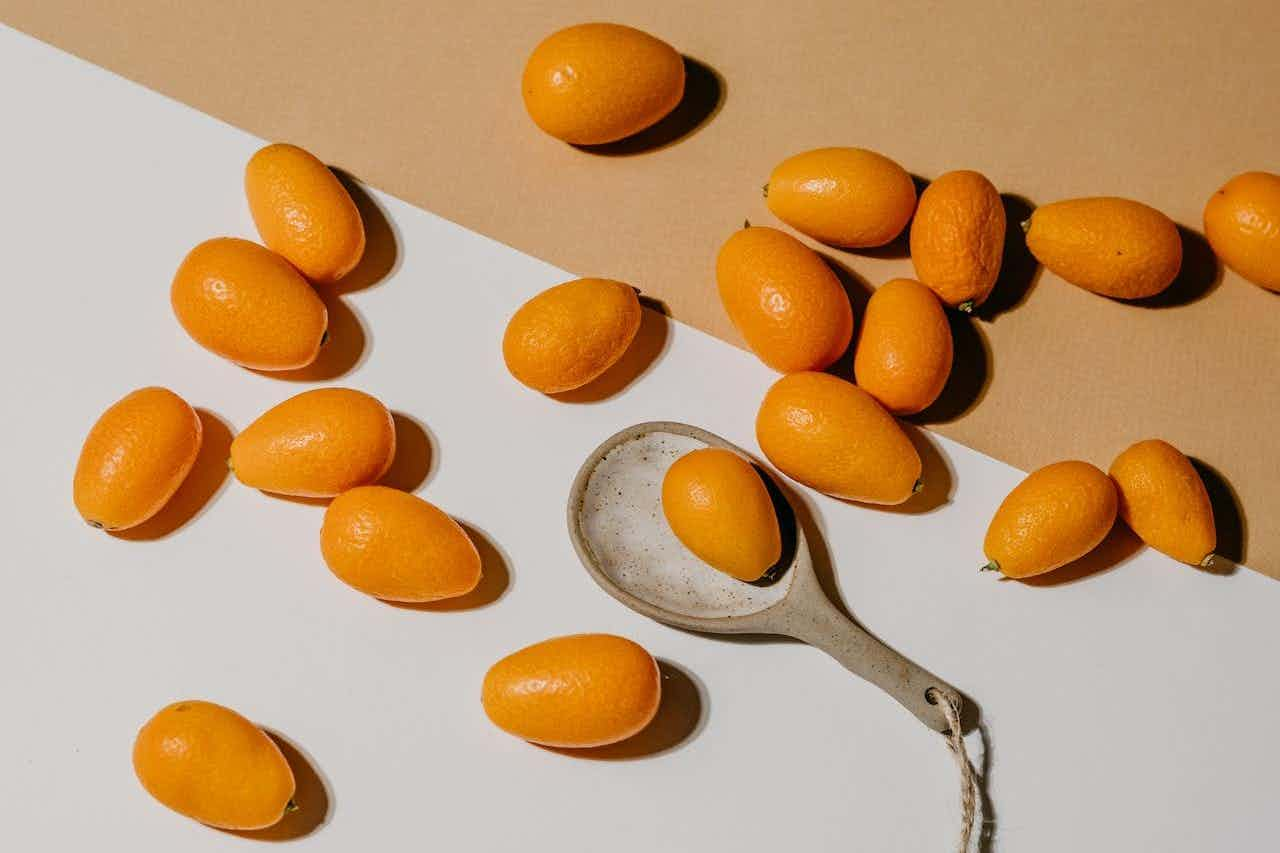A fruit that can help support bone health, enhance teeth quality and even help fight diabetes, kumquats have countless benefits. But what exactly is this seemingly magical piece of fruit, and are they truly as good for you as first appears?
Frustrated with food waste or don't know where to start with a shopping list? Try a food subscription box to wash those worries away and put your diet - and finances - on the right track!
The origins of kumquats
Kumquats originated in southern China, but less than a hundred years later, people discovered the kumquat tree in Japan and other parts of Southeast Asia. By the nineteenth century, people started cultivating kumquats across Europe and North America.
Today, you can commonly find kumquats growing in warmer climates such as California and Florida in the US. Although this fruit can be cold-hardy, the plant thrives in a subtropical climate, where it will produce sweeter fruits.
Kumquats are in season between November and April. You’re more likely to find them either at your local farmers’ market or a speciality Asian store as opposed to your supermarket. You can also grow your own kumquat plant, but like all citrus plants in the UK, experts recommend using a greenhouse or conservatory to have better control over the temperature.
The appearance of kumquats
Kumquats grow on kumquat trees, which produce white flowers before becoming fruit. These plants can grow up to eight feet tall and six feet wide but are also available as a dwarf variant, ideal for those growing this plant in their conservatory or greenhouse. The trees produce beautiful dark green leaves, which remain even when the fruit starts to appear.
Ripe kumquats look similar to oranges, more so an oval orange the size of a grape, depending on their variation. The most common variation of the kumquat you’ll find is the Nagami, and other varieties of kumquats include Meiwa kumquats, the spicier Marumi, and the Hong Kong variety, which you can find growing in hilly and mountainous parts of China.
When unripe, kumquats are a dark green colour. You should not eat them at this stage unless you want to experience an extremely bitter taste. Rather, kumquats should be a bright orange colour or appear as yellow-orange fruits, again depending on the variety. Their skin should also be firm and free of shrivels or blemishes.
What do kumquats taste like?
Unlike oranges, you can eat the whole fruit, including the kumquat peel. You’ll also notice seeds inside your kumquat, just as you would find in an orange. These are also edible but can taste bitter, so you may prefer not to eat them.
The sweetness of the kumquat actually comes from the fruit’s peel. When eaten whole, kumquats offer a unique clash of sweetness combined with the sour and tangy taste of the flesh, creating an incredibly distinct flavour. If you haven't tried this fruit yet, its taste can be closest to a hybrid of an orange and a grapefruit.
The benefits of kumquats for over 50s
Eating a balanced diet is especially important to maintain optimum health as we age. The best diet for after 50 focuses on getting in plenty of protein, a reduced amount of processed food and an abundance of fruit and vegetables, high in vitamins and minerals. Kumquats boast their own amazing range of health benefits, including the following:
Immune system boosting
Our immune systems weaken as we age, meaning it can be more difficult for our bodies to fight off infection when we become ill. There is no singular food that will cure illness, but studies have shown foods rich in vitamin C, such as kumquats, do aid in shortening the time of an individual’s cold. For more advice on boosting your immune system, read our previous article: How to avoid getting ill in winter.
Helps to enhance teeth and hair quality
Kumquats are high in calcium, an excellent source of vitamin C, as well as potassium and antioxidants. These can all contribute towards teeth and hair strength and overall quality. However, it’s important to note that if consumed in excess, the acidic nature of kumquats can lead to tooth decay and sensitivity.
Can improve vision
Growing up, we’re often told that carrots help us see in the dark, but what about kumquats? The high levels of vitamin A, beta carotene and lutein antioxidants aid with eye health, but these qualities aren’t unique to carrots. Vitamin A and beta carotene are also abundant in kumquats, which can prevent eye damage.
Protection against diabetes
Researchers at the University in Changsha, China, conducted a study on laboratory rats to investigate flavonoid extracts (compounds found in many plant products) in kumquat peel. The study concluded that flavonoids lowered the mice’s total cholesterol levels. And those with type 2 diabetes are at a greater risk of having high cholesterol. This area requires further research on humans, but this study indicates that this small fruit could yield significant benefits.
Aids with digestion
Help aid your digestive system with this flavoursome fruit! Kumquats are full of fibre, essential for helping waste move through the body as it should. A fibre-rich diet will ease bloating, excess gas, cramping and relieve constipation. But, as with too much of anything, those on a low-fibre diet should be mindful of overconsuming kumquats to avoid causing the opposite effect of digestive issues.
Supports bone health
Bone health can be affected by ageing, but a diet rich in calcium and vitamin D will help maintain bone health and prevent osteoporosis. For adults between 51 and 70 years old, experts recommend a daily calcium intake of 1000 mg for men and 1200 mg for women. For men and women over 70 years old, 1200 mg of calcium is recommended daily. A 100g serving of kumquats contains just over 60 mg of calcium! In just a small serving, this fruit can help to contribute towards overall bone health.
How can kumquats be eaten?
If you're not completely convinced by the taste of kumquats just yet, don't worry! There are plenty of ways to reap this fruit’s benefits whilst enjoying its flavours more subtly as opposed to eating them whole. Here are some suggestions for recipes you can make or purchase ready-made.
Kumquat marmalade
Similar to orange marmalades, chutneys, or jams, you can savour the sweet treat of kumquat marmalade spread on toast. Recipes often call for lemon rind, too, so if you’re a citrus enthusiast, this could be your new way to enjoy breakfast.
Kumquat fruit salad
If you’re growing tired of your usual fruit salad recipe, why not try adding a few sliced kumquats for a new flavour? They pair perfectly with berries and kiwis as just one serving suggestion. Alternatively, you can use kumquats in a savoury salad alongside leafy greens or in a salsa with chopped red onions and coriander.
Kumquat liqueur
Kumquat liqueur is readily available, or you can even make it at home. Think of it as a kumquat alternative to Limoncello. The drink is usually consumed on its own or mixed to create new versions of favourite cocktails such as gin and tonic. Please note that drinking responsibly is strongly encouraged, especially as overconsumption of alcohol becomes riskier the older we get, for the reasons outlined in this previous article.
Kumquat ice cream
Whilst ice cream definitely doesn’t have the benefits of a nutritious kumquat, you can incorporate kumquat ice cream into your diet as an occasional treat. Indulging in the fruit this way is great for those keen to introduce this into their diet or those who enjoy the less intense flavour of kumquats.
Roasted kumquats
Did you know you can use kumquats alongside your roast? Simply slice your kumquats, drizzle in some honey and roast in the oven for around 25 minutes at 190°C or gas mark 5.
Should you introduce kumquats into your diet?
With an array of health benefits, you can enjoy kumquats for more than just the delicious and low-calorie fruit they are. Being so incredibly versatile, too, you can incorporate kumquats into your diet with many recipes. Still not convinced? Whilst kumquats are a great source of essential vitamins and minerals, you can still reap some of these benefits from other fruits you may enjoy more, such as berries, kiwis and oranges.
Image Credit: Polina Kovaleva at Pexels









